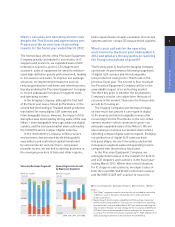Nikon 2012 Annual Report Download - page 18
Download and view the complete annual report
Please find page 18 of the 2012 Nikon annual report below. You can navigate through the pages in the report by either clicking on the pages listed below, or by using the keyword search tool below to find specific information within the annual report.
16
NIKON CORPORATION ANNUAL REPORT 2012
partner factories, and in January 2012
partial capacity had been restored at
NTC’s own manufacturing facilities. Including
alternative production at Thai partner factories,
normal production volume had resumed by the end
of March 2012.
When the flooding began there were fears
that our business might be seriously impacted
and fall into the red during the second half of the
year, but the adverse effects of the disaster were
minimized thanks to strong sales of the Nikon 1
interchangeable lens-type advanced digital camera
that we introduced on the market in October 2011,
and to growth in market share of our compact digital
cameras. The fact that we were able to achieve
profitability by the end of the second half of the
fiscal year can be taken as a solid indication of the
underlying strength of Nikon’s imaging business.
Market Prospects and Medium Term
Management Plan Strategies
Analyzing User Needs to Promote Market-Driven
Product Development
The market for interchangeable lens-type digital
cameras is expected to achieve double-digit annual
growth in unit sales through the fiscal year ending
March 2015. Although the flooding in Thailand
impacted Nikon during the fiscal year ended
March 2012, manufacturing capacity has been fully
restored, and we plan to boost our market position
significantly during the fiscal year ending
March 2013. Meanwhile, the size of the
compact digital camera market is expected
to remain flat at around 100 million units per
year through the fiscal year ending March 2015.
Following our success in the U.S. market, Nikon’s
highly focused marketing efforts enabled us to claim
the top share in the European market for the fiscal
year ended March 2012. Competition is becoming
increasingly fierce, but we intend to maintain our
leading market position through the effective
combination of desirable products, compelling
advertising, and strong marketing capability.
To increase the Imaging Company’s market
share, our current Medium Term Management
Plan calls for the “steady introduction of new
products with distinctively superior technologies.”
The Nikon 1 interchangeable lens-type advanced
digital camera represents one fruit of this ongoing
strategy. The Nikon 1 is favored by women and
young people, segments of the market where Nikon
has traditionally been weak. However, it is also
accepted as an attractive second camera for digital
SLR owners. As a result, the Nikon 1 is succeeding
in carving out an entirely new market, distinct from
the conventional digital SLR and compact digital
camera markets. The reason for its success among
consumers lies in the fact that the technologies
used in this camera were developed as the result
of a thorough analysis of actual user needs. For
example, users of compact digital cameras tend
to report dissatisfaction with the autofocus speed.
The Nikon 1 addressed this issue by introducing
the world’s first* image sensor, created for
Digital SLR Camera
Nikon D3200
Digital SLR Camera
Nikon D800
Digital SLR Camera
Nikon D4
























